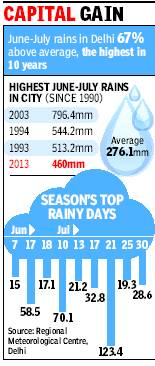Rainfall: India
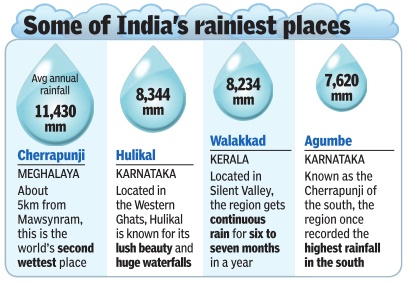
This is a collection of articles archived for the excellence of their content. |
Contents |
2013
Country sees wettest June-July in 19 yrs
The Times of India 2013/08/02
The June- July 2013 rainfall, which has been 117 % of the long period average [LPA] is the highest the country has seen since 1994. The last time there was more rain during this two-month period was in 1994, when the monsoon was 123% of the average. The 528.1mm rain bounty that the country got in the first half of the monsoon season is the third highest in 50 years. The wettest June-July spell during this period was in 1994 (564.7mm) while the second wettest was 1964 (538.1mm). Another interesting feature of this year’s rains has been the absence of a break in the monsoon ever since it covered the entire country in June 16.
Jun-Jul 2013: With 460mm rain, city’s wettest in 10 years
Amit Bhattacharya TNN
The Times of India 2013/08/04
New Delhi: The first two months of the monsoon season have been wettest in the capital in the past 10 years. Delhi’s June-July rain tally stood at 460mm, 67% above normal, which is the second highest of this century after 2003.
The city’s rain aggregate got a huge boost in the second half of July. According to figures provided by the Regional Meteorological Centre, the capital got 238.9mm of rain during July 16-31, which is more than the average for the entire month.
There were 10 rainy days during this period, including the season’s wettest day (July 21), when 123.4mm came down on the city. This late surge lifted July’s rain tally to 340.5mm, 62% higher than the month’s average rainfall of 210.6mm. Since 1990, there have been only three years when the city has got more rain in June-July than this year. Apart from 2003, the other bountiful years were 1994 and 1993.
While the rain gods have been kind to Delhi, in neighbouring Haryana it’s been a different story. The meteorological district comprising Haryana, Delhi and Chandigarh is the only one in north India where rains have been deficient so far. That’s mainly because of poor rainfall in Haryana.
2015
2015: July

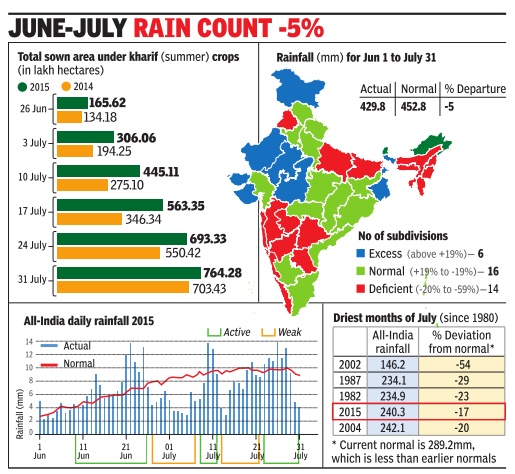
2015: Lowest rainfall in 6years
The Times of India, Oct 01 2015
Neha Madaan
Monsoon ends with lowest rainfall in 6 yrs
The monsoon season ended on Wednesday with a 14% deficit, making it the weakest monsoon since 2009.In terms of average countrywide rainfall during the season (June-September), this year was the third lowest since 1979, the other acutely deficient year being 2002. The country received 760.6mm rainfall during the June-September monsoon season as against the normal 887.5 mm, which is less than last year's monsoon performance of 781.7mm. With this, the country has seen two backto-back droughts, the first since 1986-1987.
In September, despite a few late spells of rain in several parts of the country including deficit regions such as central Maharashtra, Marathwada, south peninsula and northwest India, the total rainfall was the lowest since 2005. The country received 131.4mm rainfall in September this year, 24% less than the normal and the lowest in the past 11 September months. In 2002 and 2009, the two worst drought years the country experienced in recent decades, the rainfall deficiency stood at 19.2% and 21.8%, respectively . The India Meteorological Department has, however, discontinued using the term “drought“ because it believes an entire country never faces a drought.
2015: 302 of 614 districts drought affected, highest since 2009
The Times of India, Oct 03 2015
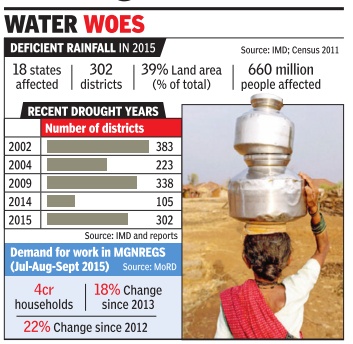
Subodh Varma 302 of 614 districts reeling under drought, highest since 2009
There is more to this year's rainfall deficit than meets the eye. After the monsoon was officially declared over on September 30, 17 of the country's 36 weather subdivisions had received deficient or scanty rainfall. That's about 39% of the country's area, home to over 66 crore people, nearly half the country's population. Deficient is when rains are below the average by 20% or more while scanty is when it's below 50%.
Deficient or scanty rains have affected people in 302 districts out of 614 that have sent in their rainfall data to the Indian Meteorological Department (IMD). Details of some 27 districts mainly are yet to come in. Eighteen out of 36 states and union territories are affected. Some of the top grain producing states like Punjab, Haryana, UP , MP and Bihar are part of this belt.These are also areas of high population density , and high dependence on agriculture.Considering the gigantic scales involved in this drought, it is surprising that not much alarm or preparation is visible at the policy makers' level.
The last time a drought of this scale was witnessed was in 2009 when 338 districts were affected. In 2002, 383 districts were drought stricken. In 2014 the number of districts affected by deficient rains was 105.
There are other worrying indicators also. In the 91 big reservoirs in the country , current water storage is 61% of their total live storage capacity, according to the latest data from the Central Water Commission (CWC). This is significantly lower than the 10-year average of 77% storage. In the southern region live storage is just 34% of capacity compared to average 81% for the last decade. In the coming days when this reservoir stored water will need to be used for irrigation, power generation and drinking, this shortage will come into play . It will also mean additional pressure on an already overdrawn ground water reserves.
Food grain stocks were 509 lakh metric tons (LMT) on September 1 this year, lower by 15% over the 602 LMT stock last year. This is not because of the monsoon but probably due to the 4.7% dip in grain production last year and only a nominal increase in the minimum support price offered by the government to the farmers. But low stocks is worrying because this is what is going to be consumed till the kharif harvest comes in.
So, what about the kharif crop that was sown in this monsoon? According to the first advance estimates by the government, the hope is that kharif production will be 124 million tons. This is mainly rice, pulses and coarse grains.Last year, kharif production was 126.3 million tons. So that's a shortfall of 2%.
But experts say that these first estimates are based on sowing of crops. How the standing crop fared in its life is what determines how much food grain it provides. It is here that the current drought's peculiarities will matter.
In June this year, rainfall was 16% higher than the long period average. This led to hopes of a good monsoon.So, sowing was done vigorously.But then the rainfall plummeted.
Punjab and Haryana
Rain woes in Punjab and Haryana
The Times of India, Jun 03 2015
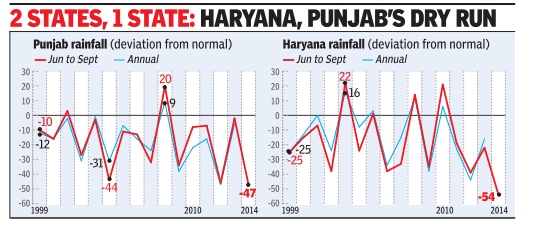
Amit Bhattacharya
SHOWER SHORTAGE - For 2 grain-bowl states, below-par rain for 16 years
IMD's monsoon update predicts 85% seasonal rains for northwest India, indicating that rain woes of the agriculturally crucial states of Punjab and Haryana could continue for another year.
Both states have witnessed meteorological droughts in five of the last 10 years, meaning rainfall in half of the past decade has been at least 25% below the long term average (LPA). Last year's monsoon season was among the driest in the recorded history of both states. Punjab received 243.5mm of rain against an LPA of 491.5mm, posting a 50% deficit for the season. It was the second worst monsoon in the state in 113 years (1901-2014), next to only the 67% deficit seen in 1987.
Haryana had an even greater deficit of 56%, with the state receiving 200.1mm rain as against an LPA of 460.3mm. Only two monsoons since 1901 have been worse in the state.
More worryingly, the distress is not limited to the past decade. The two grainbowl states, which were at the forefront of India's green revolution, have been getting below par rainfall for the past 16 years.
According to Met department figures, Punjab has seen just two above normal monsoons since 1999. The last time that happened was eight years ago, in 2008.
Haryana's plight is similar. The June-September rains in the state have been above par on just four occasions in the past 16 monsoons.
Some experts see the chronic monsoon deficien cy in the two states as the worst symptoms of a larger and natural monsoon cycle, which has been in the downswing phase in the past several decades.
Other experts TOI had spoken to when it highlighted this trend last year were of the opinion that the deficit went beyond natural monsoon variability and needed to be investigated.
Interestingly, all through this one-and-a-half decades of depressed rainfall, the ag ricultural output of the two states has been rising.
That's because farmers have been tapping deeper and deeper into the groundwater resources of the region.
According to a Central Ground Water Board report, Punjab overexploits its groundwater annually by 170%, the highest in the country . Of the 138 blocks in the state, groundwater is overexploited in 110 (80%).Haryana is not far behind, with 59% of blocks labelled overexploited.
Many studies, including those using satellite data to map the groundwater situation, have shown that such drawals were unsustainable and the region was fast reaching the limits of such overexploitation.
Punjab and Haryana: Drought years since 1998
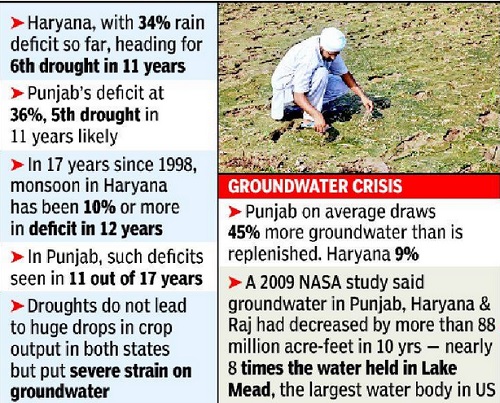
The Times of India, Sep 05 2015
Amit Bhattacharya & Ikhhlaq Singh Aujla
Haryana faces 6th drought, Punjab 5th
As monsoon begins to withdraw from northwest India, the grain bowl states of Punjab and Haryana head for yet another drought -the fifth and sixth, respectively since 2004. In an alarming trend over the past two decades, the two states have consistently received below normal monsoon rainfall since 1998.
Out of 17 years since 1998, Haryana has received at least 10% below normal monsoon rains in 12 years. The corresponding figure for Punjab is 11 of out 17 years, counting the present year as deficient.
Punjab currently has a monsoon shortfall of 36% and Haryana 34%. These deficits are likely to grow as little rain is expected after the monsoon withdraws. Last year the two states received around 50% of normal monsoon rainfall.
